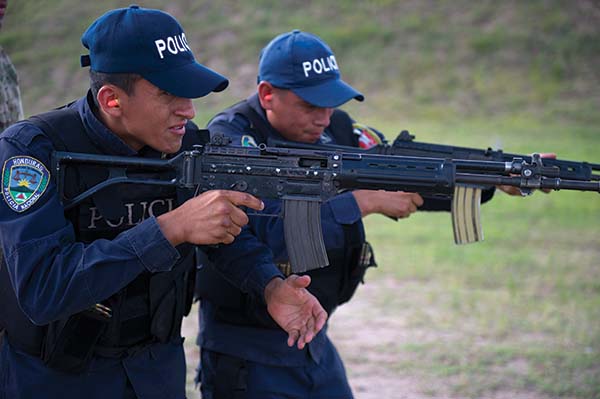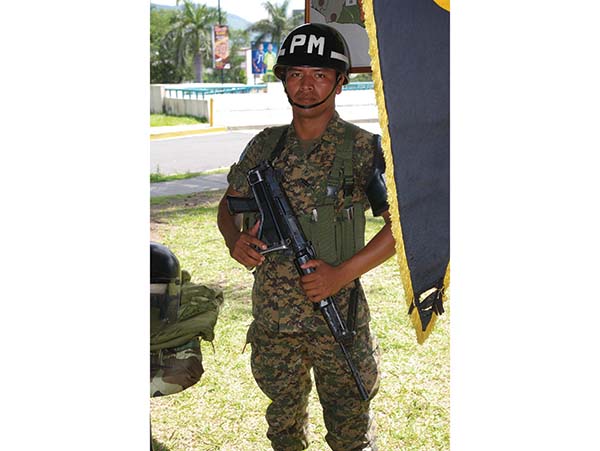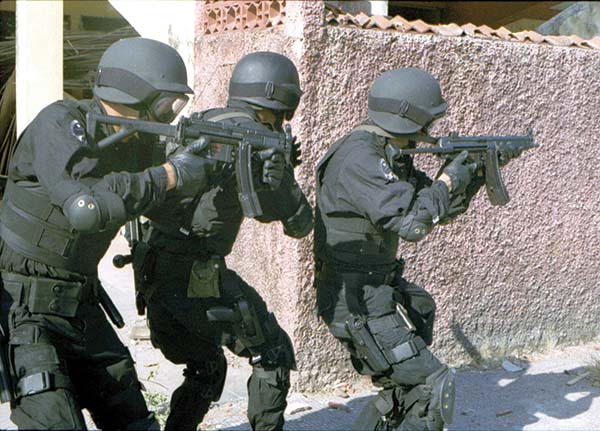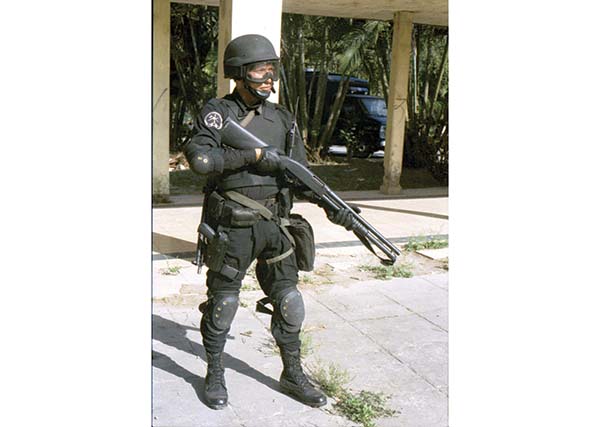ABOVE: TIGRES operators are trained at Lepaterique, Francisco Morazán, where they attend a 12-week course provided by Colombian police Jungle Commandos, and 7th USSF Group, along with Chilean Carabineer advisers. This police squad is equipped with Dashprod M14/AR-M4 rifles. (U.S. Army photo by Spc. Steven K. Young)
Violent crime in the Central American “northern triangle” is reaching unprecedented levels, with murder rates among the highest on the planet. Its effect has even shaken U.S. borders, with up to 70,000 unaccompanied minors calculated to have arrived by the end of 2014 illegally into Texas. These numbers were calculated after the Border Patrol apprehended 20,000 children in May and June, and another 5,508 in July 2014. The kids are mainly being displaced by the violence, with their parents preferring to risk their trek from home to the north than to allow them to fall victims of the local gangs and crime. Nowhere else is this situation more latent than in what is known as the Central American “northern triangle,” a region comprising Honduras, El Salvador, and Guatemala. The violence is fueled by drug trade, gang warfare, organized crime, weak state institutions, rampant corruption and impunity.
These three countries in particular have the unique misfortune to be located geographically between the world’s largest drug producers in South America (Colombia and Ecuador) and the world’s largest consumer of illegal drugs, the United States. The region is flooded with drug money, bandits and all sort of economic and political problems.

In addition to the availability of quantities of weapons left over from years of wars, police and military arsenals have been made available to criminal enterprises. In El Salvador alone, between 2009 and September 2014, the national Civilian Police (P.N.C.) had confiscated 68,198 weapons. The problem appears to be more serious in Honduras, where huge amounts of police firearms have been lost. A few years back, in 2011, for instance, the Honduran government announced that 300 FAL rifles have been lost from a warehouse, under the watch of the C.O.E., the elite police command locally known as COBRA. Previously, in 2008, the then National Security Secretary, Jorge Rodas Gamero, acknowledged the loss of 98 Beretta AR-70/90s, 40 Galils, and 9 M16 rifles, along with five gas grenade launchers, 32 CZ-75s and two M9 Beretta pistols. Investigations had started after a suspect was apprehended with a Galil, along with 9 AR-70/90 rifles, with their serials traced to the police warehouse. By 2011, it was calculated that the police had lost thousands of weapons, to include AK-47s stored at the COBRA’s HQ and the rest at the installations of the National Border Police, or D.N.S.E.I. (for ). Later that same year, another 20 M9 Berettas and 20 CZ-75s had been lost at the Police Technical Institute (I.T.P. – Instituto Técnico Policial) at La Paz, and another 32 pistols at the Public Ministry.
With its police completely in disarray and in disgrace, and flooded with emergency calls and chaotic criminal situation, the Honduras government desperately looked for fast solutions. By 2012, it had created the Public Order Military Police (P.M.O.P. – Policía Militar del Orden Publico), and by 2013 the National Inter-Agency Security Force (FUSINA). This was followed by the establishment of the Investigations Police Task Force (F.T.P.I. or Fuerza de Tarea Policial de Investigación) by merging the mentioned DNSEI with the National Criminal Investigations Directorate (D.N.I.C. for Dirección Nacional de Investigación Criminal). Similarly, in El Salvador, a completely new Anti-Gang Directorate was organized to fight street crime. Guatemala increased its police and military forces, organizing them into task forces to fight back.
LINCES, COBRAS, TIGRES and Other Exotic Animals
A National Police was established in Honduras around January 1882. This was reinforced with diverse organizations until June 1959, when it is replaced with a Civil Guard. In 1963, the government creates the Special Security Corps (C.E.S. – Cuerpo Especial de Seguridad), along with the Rural Detachment and the Road Patrol, and from 1974, a Treasury Police. In January 1975, Honduras started to concentrate all different police and law enforcement elements into what became known as the F.U.S.E.P. (Fuerza de Seguridad Publica). As part of the Armed Forces, these policemen were equipped with Browning-HP pistols, Uzis, and some M16A1 and Mini-14 rifles. FUSEP became formally established under Decree No.369, on August 16, 1976, and was reequipped with FAL-50-00 and FALO-50-42 rifles acquired from the Fábrica Militar de Armas Portátiles Domingo Matheu, Rosario, Argentina. Within the FUSEP, the military established the Internal Security Detachment (D.I.S.), and in March 1979, FUSEP was reorganized in squadrons, subdivided into detachments, sections, platoons, and teams. The following month, a DIS Military Police Platoon transformed into the LINCE Squadron, tasked with rapid police response.

Towards the late 1970s, FUSEP established an Anti-Terrorist and an Anti-Riot squadron, and these, along with LINCE, become the response, combat and crowd control battalion C.O.B.R.A. (for Comando y Batallón de Operaciones y Reacción Antiterrorista). In February 1982, the unit becomes the A.E.E.C.O. (for Agrupamiento de Escuadrones Especiales Cobras), with its squadrons being divided into an Urban Special Ops. (Operaciones Especiales Urbanas), Rural Special Ops. (Operaciones Especiales Rurales), and Anti-Riot. This outfit becomes C.O.E.C.O. on April 3, 1996, with the acronym standing for Comando de Operaciones Especiales Cobra, (Cobra Special Operations Command), commanding the COBRA squadron (tasked with VIP protection, Special Ops, and Intervention), and G.E.A.S. or Special Anti-Hijacking Group (Grupo Especial Anti-Secuestros), established with 53 operators trained by U.S. Special Forces.
Under Decree No.229-96, dated December 17, 1996, FUSEP ceased to exist and all national law enforcement police functions are transferred to the new National Police under civilian command. An Internal Review Board (Junta Interventora), under the leadership of Dr. Hernán Corrales Padilla, decided in 1999 to separate the police arsenal from that of the military, and ordered the return of the FAL and M16s to the Army, and selected the Galil and Beretta AR-70/90 rifles to replace them. The CZ-75 was chosen as the standard police sidearm.
In 2008, under Decree No.67-2008, dated October 31, 2008, COECO becomes C.O.E., or simply Special Operations Command, comprising the COBRA squadron, tasked now only with special ops and intervention duties, and GEAS Squadron. Later it assumes command of the National Anti-Extortion Force (F.N.A. – Fuerza Nacional Antiextorsión), established on March 6, 2013, to operate in Tegucigalpa.
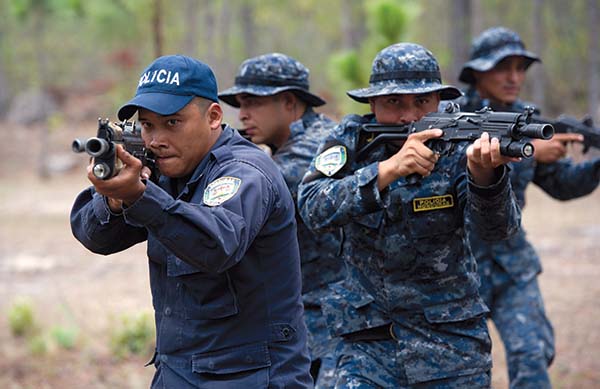
In 2014, the Honduran Security Secretariat and the National Police (PNH) experience a reorganization, and the police Special Units Directorate (D.N.U.E.) is created to oversee the C.O.E. (comprising COBRA, GEAS and FNA squadrons), and the newly established Intelligence Troops and Special Response Security Groups (T.I.G.R.E. – Tropa de Inteligencia y Grupos de Respuesta Especial de Seguridad) (fielding Alpha, Bravo and Charlie squadrons).
Parallel to the National Police, the government established the Public Order Military Police (PMOP) under the Ministry of Defense, Decree 168-2013. Each PMOP battalion comprises a headquarters element, two MP squadrons (companies), one Special Forces squadron, and a K9 unit. This translates to a force of 36 officers, 46 NCOs, 398 military policemen, and 12 K9 operators. It is expected that the PMOP Corps will eventually total 10 battalions.
From G.R.P. to G.I.A.P.
The Salvadorian Civilian National Police (P.N.C.) was established after the Chapultepec Peace Treaty that ended the internal civil conflict. As result of the Treaty, Article 159 of the Salvadorian Constitution was modified, and the three Security Forces that functioned under the Ministry of Defense ceased to exist. Under Law Decree No.269, passed on June 25th, 1992, the National Congress established a new police, and a Public Security Ministry to oversee it.

Among the three former paramilitary police forces, the National Police (NP) functioned as an urban law enforcement unit tracing its lineage to the Civil Guard established in July 1867. By the early 1990s, the NP was deployed in four metropolitan battalions (Monserrat, Zacamil, San Benito, and Honor). In addition, there was a “Panther” Anti-Terrorist Infantry Battalion, and a Special Response Team (E.R.E. for Equipo de Respuesta Especial). The NP deployed 38 police Companies, distributed among 6 Police Commands (1st San Salvador, 2nd Santa Tecla, 3rd Santa Ana, 4th San Vicente, 5th San Miguel, and 6th Usulután). Until the early 70s, the NP was equipped with M1 and M2 Carbines, Madsen M50 and Uzi submachine guns. A little later, the police received MP5 SMGs, and G3/G91 rifles. Then, the NP supplemented its arsenal with M16 and T65s and Ruger Mini-14 rifles, as well as hundreds of FMK-3 SMGs.
The new PNC absorbed most of the arsenal available to the former National Police, with exception of the G3/G91 rifles and the M50, FMK-3 and MP5 SMGs. The Army transferred all the M9, Browning-HP, and any other pistols and revolvers at hand. Eventually, the PNC adopted the Chilean SAF SMG, and the Galil semi-auto. The sidearm was also standardized, adopting the CZ-75 pistol. The Special Response Team received MP5s, HK53 and HK-33 rifles, and adopted the SIG P-228. Snipers were equipped with SIG SG2000
precision rifles.
Elite police outfits eventually concentrated into a Special Operations (Police) Directorate, comprising the Anti-Riot Unit (U.M.O. – Unidad de Mantenimiento del Orden), the Tactical Operations Unit (U.T.O. – Unidad Tactica de Operaciones), the Special Response Group (G.R.P. – Grupo de Respuesta Especial), and the Special Police Operations Group (G.O.P.E.S. – Grupo de Operaciones Policiales Especiales). UTO operates in teams of 6 agents, all equipped with Galils, who patrol in their pickups gang-infested urban areas. The GRP was established with assistance from the U.S. Border Patrol as their version of the special tactics and weapons unit, operating in groups of 8 subdivided in two teams. The GOPES was modelled to its counterpart in Colombia. UMO was established with assistance from the French gendarmerie and the Chilean Carabineers, and would become operationally independent, responding directly to the National Police General Directorate.
In early 2012, the PNC unveiled the Anti-Gang Intervention Group (G.I.A.P. – Grupo de Intervención Anti-Pandillas), and a complete police structure reorganization followed a few months later. The Anti-Gang Sub-Directorate was established under Executive Decree No.18, dated February 1, 2014, and immediately organized with the new GIAP, the Anti-Gang Intelligence Division, the Anti-Gang Special Investigations Division, the GOPES, and the Anti-Gang Special Investigations Division, along with the Transnational Anti-Gang Center (C.A.T.).
Inter-Agency Task Forces
As with El Salvador, the Guatemalan Peace Agreement of 1996 brought an end to the decades-long internal struggle between the Armed Forces and Communist Guerrillas. The Peace Agreement, among others, ordered the cessation of the National Police and the Treasury Police, and the establishment of a new National Civilian Police (PNCG). However, and unlike the Salvadorian case, the government was allowed to “recycle” most members of the old guard into the new organization. The new PNCG started operations in mid-1997, and operated along the 22 departments by August 1999. It initially deployed from 6 Districts, 27 Commissaries, 127 Stations, and 343 Sub-Stations. Another 8 mobile commands were established to support diverse districts within the capital.
The Police Special Forces Division (F.E.P. – Fuerzas Especiales Policiales) was established, comprising the Rapid Reaction Group (G.A.R. – Grupo de Acción Rápida); the Police Intervention Force (F.I.P. – Fuerza de Intervención Policial); and the Police Special Group (G.E.P. – Grupo Especial Policial). However, FEP is basically an anti-riot outfit comprising some 650 elements. It does not have a specific group or team equivalent to a SWAT. In November 2014, the PNCG established the Wolf Unit, a motorcycle special police force, trained and equipped to maneuver in the gridlock and narrow streets to respond to emergencies and to chase criminals.

The vacuum created by a decreasing military presence, and an ineffective, weak and badly equipped police force, was filled by Mexican drug cartels partnering with local thugs. The cartels stormed into Alta and Baja Verapáz, Petén, and most departments in the country. Finally, the government decided to bring back the Army and increase police. In order to take back the cities and fields, combined tasks forces were established with U.S. assistance, and a complete rearmament took place.
By November 2014, the Chortí Task Force was consolidated with hundreds of policemen and soldiers to operate along the Honduran border. This outfit would eventually receive some 40 J8 troop/cargo transports and APV models, and new weapons; it would be the latest of about 10 task forces organized to fight all sort of crimes and problems.
The Guatemalan National Police was equipped with elderly M1A1 Thompson and M3A1, as well as MP-38 SMGs, Winchester M1 and M2 carbines. As the PNC deployed, it was reequipped instead with thousands of Uzis, and AKM rifles left over from the internal conflict. FEP took instead over 2,000 new IWI Tavor-21s to equip all its forces. By late 2014, the PNCG had reached 30,000 policemen, and was planned to increase to 35,000 by 2015. With this in mind, the Ministry of the Interior had ordered 33,000 pistols, SMGs and rifles to be supplied between 2014 and 2016.
Police Arsenals

It is still common to see Browning-HP pistols in the hands of police officers from all three countries, Guatemala, Honduras and El Salvador. However, most common in the hands of law enforcement in the region is the CZ 75, produced by CZUB in the Czech Republic. Guatemala was actually one of the first countries to make the CZ-75 its standard military sidearm, and consequently passed to the police; thousands more have been incorporated into the police forces of Honduras and El Salvador.
The Uzi and MP5, along with a few MP-12s, are found in the hands of police forces in the region. The Chilean FAMAE (Fábricas y Maestranzas del Ejército) delivered hundreds of SAF submachine guns, mainly to the Salvadorian Police. The weapon started production in 1993, as a blowback-operated submachine gun, firing from a closed bolt.
In 2010, the Salvadorian PNC invested in 700 M4 carbines and 1,760,000 rounds in 5.56mm, and another 1,480,000 in 9mm. In mid-2014, it announced the purchase of 1,426 PT92 AF pistols from Taurus in Brazil, for $900,000, and another $235,000 in 500,000 rounds of 5.56mm ammunition. The deal was done through Centrum S.A. de C.V., the same intermediary that had supplied the Galils and probably the Galil-ACE. In addition to the PT92 AF pistols, the deal included spare parts and single examples of PT917 Compact, P24/7 G2, and PT809C pistols, two SMT-9 SMGs and one LT37/38 grenade launcher (probably for testing purposes).
Forjas Taurus S.A. has produced the SAF as well, and now it is marketing the SMT-9 with law enforcement in mind. The SMT-9 feeds through curved 30-round magazines, and uses a blowback-operated system firing from a closed bolt at a cyclic rate of fire of 700 to 800 rpm. Although the SMT-9 is chambered in 9x19mm, it uses a Taurus 5.56x45mm caliber rifle platform in the form of the IA2 modular assault rifle system (a design from the Brazilian State-owned IMBEL). Interestingly, if the SMT-9 is adopted by the Salvadorian PNC, logically, the semiautomatic CT-556 in 5.56mm caliber should also be considered since it has been conceived as police patrol rifle. It sports the same folding stock that extends in three positions to adapt to the shooter’s build. The gun has a fully machined lightweight aircraft-grade aluminum upper receiver, and a fiberglass-reinforced polymer lower receiver. It is STANAG 4179 compliant, so it uses NATO-standard magazines, and sports a full-length top Mil-Std 1913 Picatinny rail.
In December 2010, the Guatemalan police had ordered 8,000 Jericho pistols and 3,000 Galil-ACE 31 and 32s in 7.62x39mm (to back-up the existing AKMs). The contract was politically resisted, and eventually was partially abandoned in early 2011. In August 2013, the PNCG announced renewed contracts for over $12 million with Pietro Beretta SPA, Israel Weapon Industries Ltd. (IWI) and Glock America SA, for more than 17,346 weapons. The deal specified 14,000 Pietro Berettas, 3,000 Glocks, 100 rifles, and 100 Uzis. Later it was indicated that there was a lag of 6,000 weapons to supply the police, so the orders had increased to 33,000 weapons, to include 25,000 pistols, 4,000 SMGs, and 4,000 rifles.
Most common in the hands of police forces in Honduras and El Salvador had been the Taiwanese T-65. The Asian allied delivered hundreds, if not thousands, of their M16 look-alike. It has resurfaced with the Honduran National Police. In El Salvador it was issued exclusively to the police and some National Guard units, and then passed to the PNC. The most common variant observed has been the Type-65, much similar actually to the ArmaLite AR-18, lacking the distinctive carrying handled of the M16. The T65 is said to use a short stroke gas piston, and it uses the same M16 magazines. In March 2010, the Salvadorian Army supplied 700 T-65 rifles to the PNC to expedite the re-equipment of police units; however, these were almost identical to the Colt M16, sporting the typical carrying handle, which indicates they were Type 65K2 models.

The Honduran Police Internal Review Board ordered in 1999 to replace the FAL and M16 rifles in police use with semiautomatic Galils and AR-70/90 rifles. The acquisition of the Beretta 70/90 to equip the Honduran police between then and 2001 is a little puzzling. The rifle is uncommon in the region, and even uncommon outside Italy. The rifle traces its lineage to 1968, when the Italian company started developing its own assault rifle in 5.56mm. This resulted in the AR-70/223 model presented in 1972. This initial model evolved in the mentioned AR-70/90. This is a conventional gas operated assault rifle, using the STANAG magazines (M16 type). It has a detachable carrying handle, and it is equipped with NATO-standard accessory rails. Honduras would receive the SC-70/90 variant, with folding stock, and the short-barreled SCP-70/90 carbine, also with skeleton metallic buttstock. The deal appears to have involved Mod 93R automatic machine pistols, also from Beretta. This is a variation of the Mod 92/M9, with a selector for three-round bursts.
Between 1999 and 2001, the Honduran and Salvadorian Police ordered over 2,000 Galil rifles each, in semiautomatic mode only. These were probably the last rifles built by IWI since the production of the rifle switched to the Colombian Indumil, and it is not known that Colombian examples have been acquired by those countries. When Honduras needed additional Galils for the police, it resorted to the Dashprod SAR M14 and Arsenal AR-M4 SF models. The Dashprod resembles the Galil since its mechanism is identical to that of the AKM. In fact, it uses a receiver from a “Suchka” – a short AKM-AKSU “Krinkov” (also known as Krinks) made in Bulgaria and modified by Dave Sheer Products from South Africa. It uses the same folding stock found in the South African R rifle series (Galil), and shares the same 35-round magazine. It is chambered for the NATO 5.56mm caliber (.223), with an overall length of 730 mm, which reduces to 504 mm with the stock folded. Barrel length is only 215 mm, having a weight of 3.2 kg and a
rate of fire of 720 rpm.
It appears that the rifle has been supplemented as well with the Arsenal JSCo. AR-M4 SF. This is actually the Bulgarian made AKSU receiver modified as the SAR M14, in 5.56mm, with short barrel, folding butt, and reinforced glass fiber used in the lower and the upper handguards and pistol grip. It can be equipped with Tritium Self-illuminated Night Sight (3-dot sights), and sports a unique muzzle brake/flash hider – as does the SAR M14. They are also equipped with a build-in tactical flashlight. Its rate of fire seems to be lower at 600 rpm.
In Honduras, over 5,000 Galil-ACE examples have been acquired to completely equip the PMOP since this is a military unit, and its weapons must be different, by law, from those used by the police. PMOP operators have also been equipped with 5,000 protective vests, and S&W .45 pistols as well as reincorporating some of the 1,866 M1911A1s from Army arsenals. In El Salvador, some 2,000 Galil-ACE examples have arrived to equip the Anti-Gang units. Among the thousands of rifles ordered by the Guatemalan Police, the Galil-ACE is included as well. No question that this Israeli rifle appears to be the future standard weapon of the northern Central American triangle’s law enforcement agencies.



